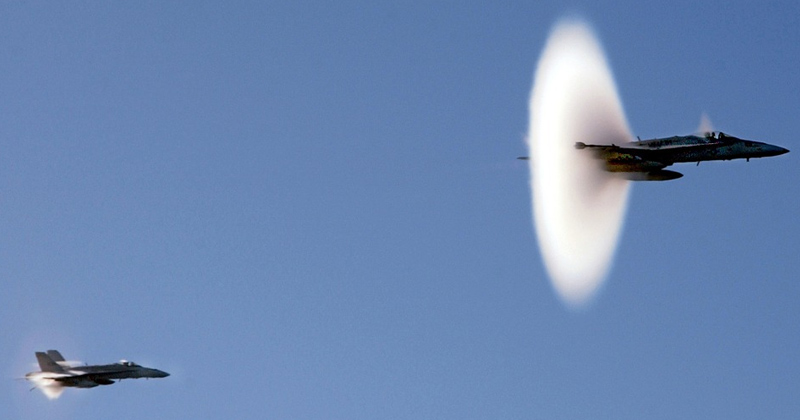Airplanes and lashes have something in common, they can break the sound barrier with a bang or sonic boom. You might have even heard the sound barrier, breaking. It recently happened in Bengaluru when people claimed they have heard the noise from an alien aircraft. But what is the reason for sonic boom, the bang when the sound barrier is broken and how do you imagine the wall? Let’s find out.

First, you see it and then you hear it. A jet fighter rushes past with incredible speed. A couple of seconds later, the pilot only appears as big as a fly but the sound of the aircraft booms in the ears. The sound called the sonic boom is heard when the fighter jet has broken through the sound barrier. It means that it has gone past the speed of sound.
So, is there a barrier that is responsible for the noise? There is actually a kind of wall in the air and it can be better explained by the term ‘wall of resistance’. The sound always spreads spherically similar to the circular waves that a stone creates when it falls into the water.
Jet fighters are not stones, but high-speed planes. The sound waves rushing away from the aircraft spread quickly, but not rapidly enough. The jet slowly but surely catches up with its own sound creating a sonic boom.
During the Second World War, the first aircraft were already close to breaking the sound barrier. Some types of fighter planes were able to reach speeds of sound in a dive, but could not break the sound barrier. The problem is that the faster the aircraft gets, the more sound it pushes in front of it. The airflow becomes stronger and the flight behavior uncontrollable.

This effect can be checked with a pen. Simply dipped into the water, it creates circles like the stone. But when the pen is quickly pulled through the water, the waves pull behind it and a bow wave foams up at the front. When viewed from above, an image created looks like a triangle. The tip is at the front of the pen, the waves drift away from it.
It is the same with sound, only three-dimensional. It moves in a cone shape behind the aircraft. And at the front of the plane, the wave jams out of air. This phase can be compared to a stretched cloth into which a finger is bored. The cloth falls off conically behind the curvature. Finally, it becomes critical when the cloth breaks and the finger pierces.
Suggested Read: How Dangerous are Meteorites? Are They Nature’s Bullets For Us? Let’s Find Out
The Breakthrough Came in 1947
The breaking of the sound barrier actually took place for the first time in 1947. The Bell X-1 rocket plane was not only fast enough but it was also stable. The resistance in the air built up to a speed of 340 meters per second in front of the rocket jet. It became as quick as its sound. The desired effect finally came when the plane pierced its own sound barrier with an extra boost.

Since then it has been booming everywhere. Jet fighters, bullets, and helicopter rotor blades rattle the sound barrier every day. The bang can always be heard when an object whizzes past our ears at supersonic speed regardless of whether it’s an airplane, ammunition, or a whip.
Indiana Jones’ favorite toy is one of the most remembered examples of overcoming sound barriers. With every blow, the sound travels along the whip rope like a wave. At the top, the energy is released and hits a speed of Mach 2 within 0.0026 seconds and we hear the sonic boom.
The term Mach 2 is used in aviation. It describes the speed of an object with relation to sound. If it moves with Mach 1, it is as fast as the propagation of the sound. However, if the object moves faster than Mach 1, it overtakes the sound. The result is Mach 2 which is supersonic speed.
The sound can always be heard as a loud bang when the jet plane whizzes past and tears its own sound cone behind it. However, the phenomenon cannot be seen as the wall remains invisible.
Suggested Read: Dragon capsule can be the First manned test flight to the ISS. More about the SpaceX dream, here
However, an interesting condensation effect can be seen when flying. An aircraft that is still far below the speed of sound is still exposed to high air currents. On a suitable aerodynamic surface, for example on the wing, the airflow gliding past can reach supersonic speeds.
At this point, supersonic shock waves form on the aircraft. If the aircraft now increases its speed, the flow of air also increases. This releases the supersonic shock wave and suddenly creates negative pressure. With this sudden drop in pressure, the air cools down in a matter of seconds. As a result of this cooling, the water condenses in the air and a milky cloud disk is formed.


